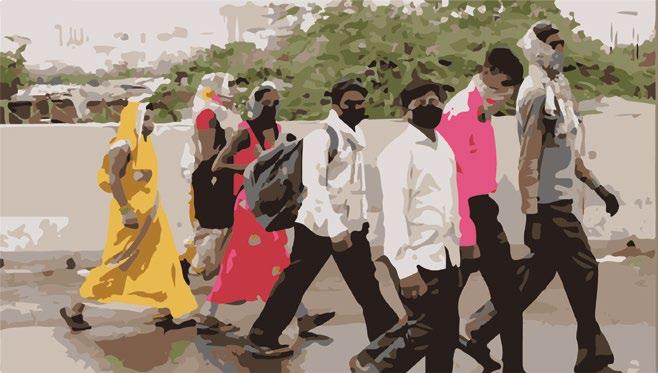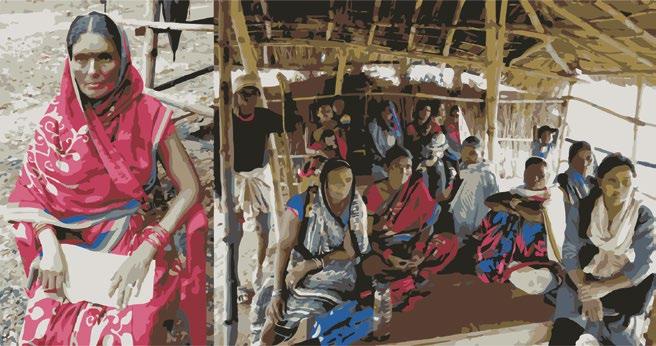
7 minute read
Criminalizing Protest
Ciminalization of protest
In a democracy, the right to protest is inherent in the right to freedom of speech and expression. In Indian Constitution, this right in enshrined under Article 19(1) (a), albeit with certain limitations or reasonable restrictions. Protests have been widely used as tool of dissent in India against government authorities and its agencies. But there is a stark difference in how protests were handled in the pre-2014 times versus how they are viewed today. Not only has the word ‘protest’ gotten a negative connotation and viewed as an ‘anti-national’ activity, the State has increasingly dealt with protests with an iron hand in the past few years. After the Citizenship Amendment Act (CAA), 2019 was passed in a roughshod way without entertaining legitimate amendments from the Opposition, there was a major outbreak of protests across the country. The CAA 2019 is viewed as a highly divisive law with the ultimate aim to discriminate against Muslim minorities from outside the country and eventually also to be used as a weapon against the ones within.
Briefly, the law enabled religious minorities, except Muslims, from three neighboring countries, Pakistan, Afghanistan and Bangladesh, to get citizenship of India. Without delving deeper into it, the law is prima facie unable to justify reasonable classification as permitted by the Indian Constitution and resorts to abject discrimination on religious grounds which is against the basic tenets and structure of the Indian Constitution.
It was against this law that a wave of protests began in different parts of the country. People were out on the streets, being part of peaceful march, rallies and University students were a significant part of these protests. Of the many peaceful anti-CAA protests in Delhi were the protests outside Jamia Milia Islamia
University (JMIU), Delhi in February 2020.
A democratically elected government, which may have anticipated protests, instead felt threatened by them and be-gan using brute force against young protestors on December 15, 2019 (JMIU, Aligarh Muslim University-AMU, Uttar Pradesh-UP1), January 5, 2020 (Jawaharlal Nehru University-JNU, Delhi) and in four cities of northern UP from Decem-ber 2019 into January 2020. Dozens of protestors were also unlawfully arrested in acts of state intimidation. If not for the COVID-19 pandemic, the protests would have continued in some form or the other but the voice of dissent con-tinues to echo. The behaviour of both the Delhi police (evidenced in video footage showed brute violence, sexual as-sault on students of JMIU an internationally renowned university) and similar brutality was visible at AMU and JNU apart from other locations. It was the police brutality at JMIU that led to women community elders to stage the historic sit in at Shaheen Bagh, a protest that captured the imagination of India and the world. In Assam, curfew was imposed, police opened fire, protestors were beaten up, internet was suspended and over 170 people were arrested.2 In Uttar Pradesh, the police action was the most brutal. There were reports that minors In Lucknow around 280 people were arrested which included jour-nalist and activist, Sadaf Jafar and retired IPS officer SR Darapuri. Ironically, however in a brazen whitewash, India’s statement at the 43rd session of the United Nations Human Rights Council (UNHRC) which was held in February 2020, was that it was a nation where the right to protest was “vibrantly and noisily celebrated every day.”4
Delhi 2020 violence
The February 2020 violence unleashed in north eastern part of Delhi was driven by hate and insightful speech against India’s minorities especially aimed at those protesting the anti-Constitutional CAA 2019 and proposed NPR, NRIC. The Indian Home Minister, Amit Shah’s statement on the floor of Indian Parliament5 set the stage for the state sponsored vendetta that was to follow against the very community that had staged peaceful protests in Delhi post December 2019. He politically outlined what his party saw as a “conspiracy behind the protests” and that is how the investigations thereafter proceeded. The hate mongers, to date have not been prosecuted. Over 55 persons lost their lives in the February 2020 violence and large sections of the Muslim community lost their homes and
were arrested and tortured in Bijnor.3 work places.
Reports of the Delhi Minorities Commission6 and Independent Lawyers have documented this thoroughly.7
Legislative tools to curb protests
An increasingly emboldened and authoritarian Indian government used the COVID-19 Pandemic Lockdown to crack-down on peaceful protesters, community and family. At least 22 persons were detained under the draconian anti-terror laws in Delhi alone. The arrests of students and activists continued even during the nationwide lockdown that was imposed to control the COVID-19 pandemic. For instance, two students of AMU were arrested by Delhi Police un-der charges of sedition, promoting enmity, assault, rioting and so on for taking part in anti-CAA protests in December 2019.8 The law enforcement agencies, empowered by the impunity granted by the political executive who oversaw these actions, failed to draw a line between activities against the state and right to freedom of speech and expression while acting upon anti-CAA protestors. Among the most popular laws invoked were the National Security Act, Unlawful Activities (Prevention) Act (UAPA) and law of sedition under Indian Penal Code (IPC). It is assumed that sedition was used more often as it is a cognizable offence allowing police to make arrests immediately.9
Mostly these arrests were made to instil fear and to subjugate and suppress the protestors and their dissenting voice. There are chances that the hundreds of FIRs filed across the country during the anti-CAA protests may never come up for hearing or have a substantial outcome. It is only those prominent faces of the protest that have been hand picked and kept in custody to act as a deterrent for protestors in the coming future. During the lockdown another arrest that was made and had garnered international attention was the arrest of Jamia Milia Islamia student Safoora Zargar, who was pregnant at the time of her arrest and finally released, after many attempts at securing bail, when she was almost 5 months pregnant. At one point, a Sessions Court had denied her bail as there was prima facie case that she had conspired to “block a road”. Safoora was one of the leaders of the peaceful protests, part of the Jamia Coordination Committee. Today, she along with others like Ishrat Jahan, Umar Khalid and 19 others are charged with sedition, among other offences, as well as sections of UAPA.
In Uttar Pradesh, Dr.Kafeel Khan was arrested in January 2020 for delivering a speech at an anti-CAA protest at AMU. He was granted bail by the high court but before he could be released, he was slapped with charges under National Security Act. He was released on September 2.
About the arrests carried out during the lockdown, Rajya Sabha member Manoj Kumar Jha said, “Most judges are operating from home. Twice I saw that there were no arguments that happened, what the police wanted happened and custody of the activist was handed over to them. It is amply clear that this timing was chosen to act against these activists as courts are not going to function
normally right now.”10 Judicial intervention
The bail hearings of the anti-CAA protestors had come up before the high court’s first. The Karnataka High Court granted bail to the protestors in Mangaluru stating that arrests were made by police to hide its own excesses; howev-er it took them seven months to walk free after the Supreme Court had to intervene. Hearing a petition against the denial of permission by the Maharashtra government to organize an indefinite protest at Beed, the Bombay High Court upheld the right to protest the Citizenship Act even as it refused to go into the question of the constitutionality of the new law.11
The way forward
A penal provision, section 144 of the Indian Penal code is used by state police virtually 24X7 to curb protests of citi-zens even when political rallies and religious congregations (especially of the majority) are allowed. Protests need to be recognized as legitimate expressions of the Citizens Voice against acts of injustice by state or non-state actors Draconian counter terror laws, with no provisions for checks and balances need to be amended/repealed. Judicial Scrutiny of Executive Action against Protesters needs to become prompt and the norm
1) https://economictimes.indiatimes.com/news/politics-and-nation/jamia-violence-newcctv-footage-shows-delhi-policeattacking-students-in-library/videoshow/74157538.cms; https://theprint.in/india/governance/15-women-30-men-sexually-assaulted-by-delhipolice-at-february-caa-clash-in-jamiareport-says/479788/; https://www.aljazeera.com/news/2020/2/16/india-footage-appears-to-show-police-attackon-jamia-students; As per a fact- finding report of National Federation of Indian Women (NFIW), the police used chemical gas on a gathering of protestors that include university students and sexually assaulted men and women, while also arresting some of them. https://indianexpress.com/article/cities/delhi/jamia-police-violence-library-new-videostudents6271631/ 2) https://www.sabrangindia.in/article/175-arrested-over-1400-detained-assam-govtsays-all-well 3) https://www.huffingtonpost.in/entry/caa-uttar-pradesh-police-torturedchildren_in_5e0207b5e4b05b08babab722 4) https://www.deccanherald.com/national/north-and-central/right-to-protest-celebratedvibrantly-noisily-in-india-centretells-unhrc-808500.html 5) https://www.thehindu.com/news/national/shah-contradicts-himself-on-delhiriots/article31052878.ece 6) https://scroll.in/latest/967742/delhi-violence-minority-panel-report-blames-bjp-leadersfor-inciting-people-through-theirspeeches’; https://thewire.in/communalism/delhi-riotskapil-mishra-minority-commission-report 7) https://www.livelaw.in/news-updates/delhi-riots-causes-fallout-and-aftermath-a-reportby-citizens-and-lawyerspublished-164099 8) https://sabrangindia.in/article/attack-anti-caa-activists-continue-aligarh-muslimuniversity-amu-students-arrested 9) https://www.hrw.org/news/2020/06/15/india-end-bias-prosecuting-delhi-violence 10) https://www.thequint.com/news/india/delhi-police-anti-caa-protests-arrests-kavitakrishnan-prashant-bhushan 11) https://www.bloombergquint.com/law-and-policy/how-high-courts-have-looked-atanti-caa-protests-and-police-action










